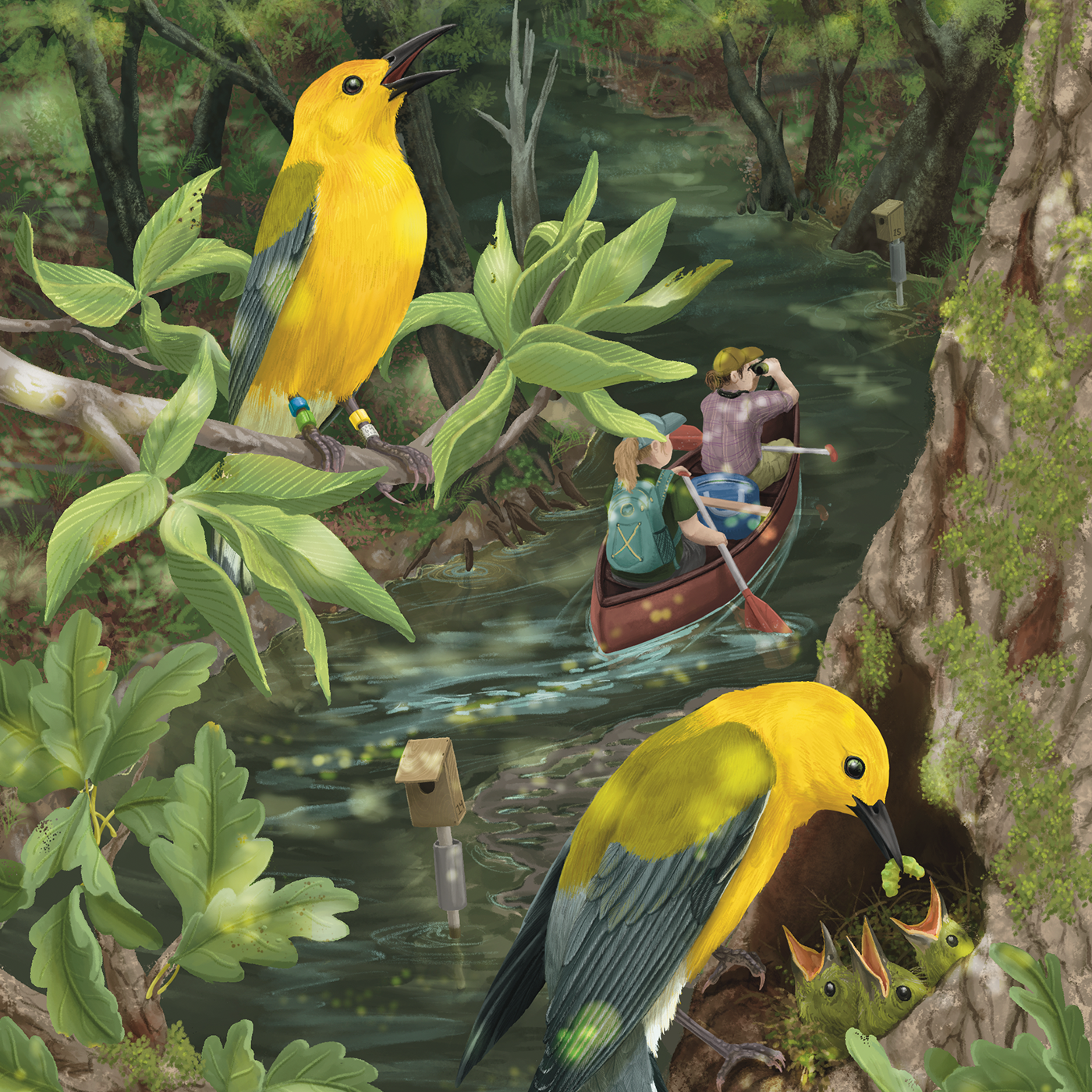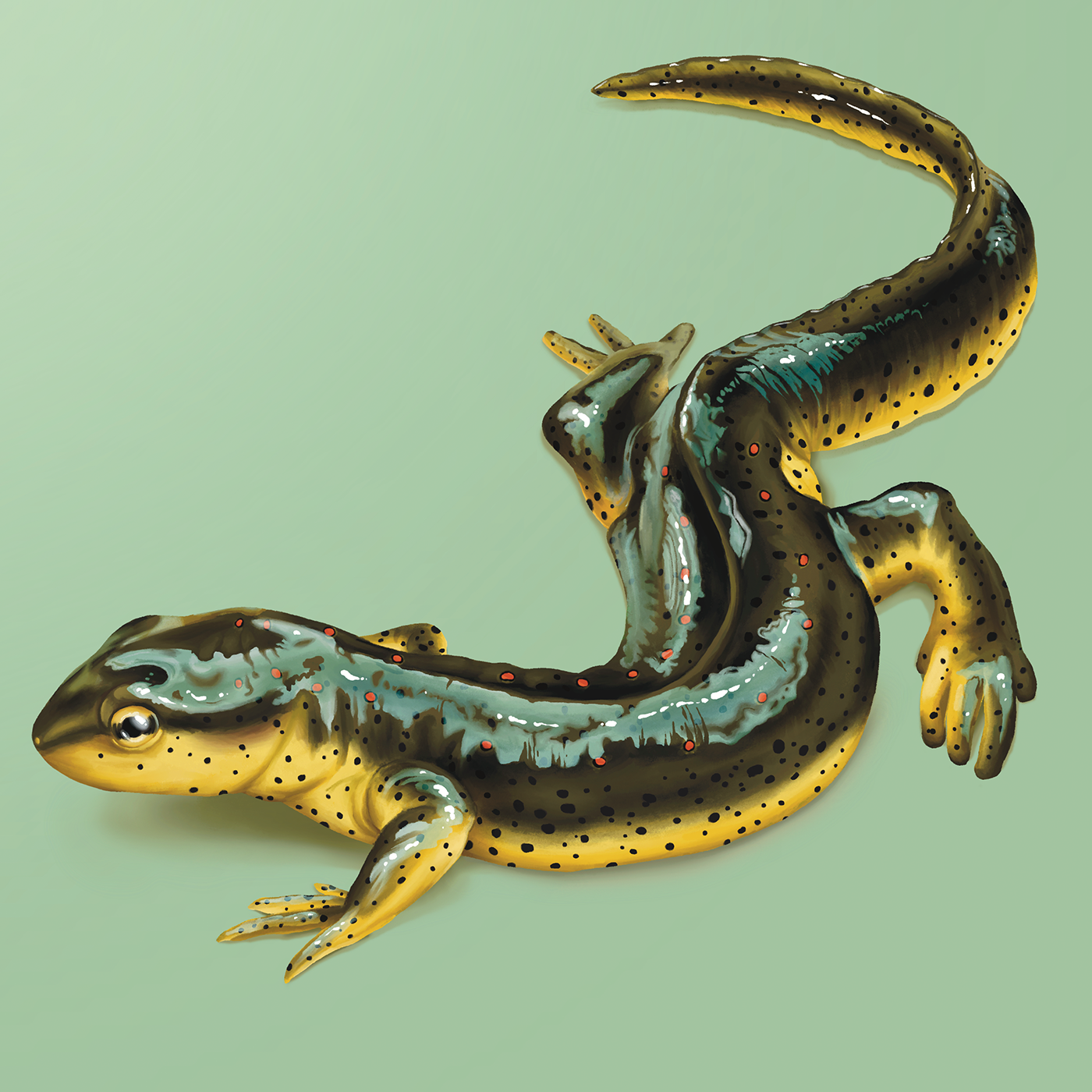
Research & Discovery
A bird call for wetland health
Humans need marshes. The prothonotary warbler can help us save them.
Childhood literacy has Dolly Parton. Disaster relief has Beyoncé. Mental health has Selena Gomez.
Every heart-tugging cause needs a photogenic spokesperson who can get people to sign petitions, write their representatives or donate money.
The one for wetland health is less a superstar and more, well, a bird. It’s the prothonotary warbler, a little gold, black and gray songbird that migrates each spring from mangrove forests in Central and South America to wetlands across the eastern United States.
And, boy, do wetlands need an advocate. They protect communities from flooding, control erosion and act as natural filters to improve water quality, but they face threats from industrial development, pollution and invasive species.
Catherine Viverette, Ph.D. (M.S.’04, Ph.D.’16), and Lesley Bulluck, Ph.D., researchers at VCU Rice Rivers Center and the Center for Environmental Studies, have studied the prothonotary warbler since the early 2000s. Every year from mid-April to late July, they visit the birds’ nests twice a week at Deep Bottom Park in Henrico County and Rice Rivers Center in Charles City.
They gather data about the birds’ behaviors, such as when the males arrive to lay moss in nesting boxes; when the females arrive and cover the moss with cypress needles or maple flower stems; how many eggs the females lay (typically around five); and how many sets of eggs the birds lay (typically two) before they return to their wintering grounds.
The research dates to 1987, when Bulluck and Viverette’s warbler-studying predecessors, now-retired VCU professor Charles Blem, Ph.D., and his wife, Leann Blem, Ph.D., an affiliate faculty member, established what is now the country’s longest-running study of the birds. The Blems set up nesting boxes along the James River near Richmond to bolster then- declining populations and learn about the birds’ breeding behaviors.
Nesting boxes are the size of a narrow breadbox and sit atop 10-foot poles along the shore of wetlands. They’re similar to the tree cavities the birds typically nest in but are better protected from predators.
Whenever a prothonotary warbler is hatched at Deep Bottom Park or Rice Rivers Center, Viverette, Bulluck or one of their students place around its leg a tiny metal band engraved with identifying numbers and plastic bands in different color combinations. Since the project began, the researchers have banded more than 20,000 prothonotary warblers, which typically live for two to five years, though Viverette and Bulluck have encountered males as old as 13 and females as old as 10.
“The kinds of questions that you can ask with a long-term data set like this are unique,” Bulluck says. “You can observe how things like temperature and precipitation change annually. That is essential for understanding how the changing climate impacts birds.”
They have found through long-term research, for instance, that warmer spring temperatures increase the chances of females laying multiple sets of eggs. But, in a sign of how complex our planet is, when average temperatures are hotter during incubation, fewer nestlings survive.
Viverette and Bulluck’s research has led to partnerships with universities and nonprofits in Louisiana, South Carolina, Arkansas, Ohio and Central America. A decade ago, researchers from eastern U.S. sites built harnesses to attach geolocators weighing a hundredth of an ounce to the birds’ backs. They learned that birds throughout the breeding range winter in a small area in Panama and Colombia.
This finding revealed how vulnerable prothonotary warblers are to environmental change. Economic development and more extreme dry seasons have led to shrinking mangrove forests, which means less food for the warblers to consume before they return to the U.S.
“The reproductive period is extremely energetically stressful,” Viverette says. The birds, which weigh less than half an ounce, migrate more than 1,850 miles to Virginia. When they arrive, they need to eat a lot of the mayflies that typically hatch around that time so they can produce and lay eggs and raise nestlings.
“But when the birds arrive isn’t based on what happened here last year,” Viverette says. “It’s based on what was happening in Panama, in Colombia, because they had to fuel up down there to get ready to migrate. And if there’s not enough food there because the wetlands are drying up, they can’t fatten up in time, they can’t leave in time, and they can’t get back here in time.”
They have found through long-term research, for instance, that warmer spring temperatures increase the chances of females laying multiple sets of eggs. But, in a sign of how complex our planet is, when average temperatures are hotter during incubation, fewer nestlings survive.
Erik Johnson, director of conservation science at Audubon Delta, one of VCU’s research collaborators, describes the prothonotary warbler as a “swamp canary in a coal mine.”
While their population in central Virginia has held steady recently, overall, warbler populations have declined by 40% since the 1960s. There’s been a steep decline in their populations in the deteriorating Maurepas Swamp near New Orleans — one of the largest cypress swamp forests in the country — over the past 15 years.
“The data are screaming at us that something needs to be done with that swamp,” Johnson says.
“Audubon advocacy work has used prothonotary warbler research to demonstrate that we need to get the restoration project implemented as soon as possible,” he says. “It resonates with certain members in our community who may not otherwise be engaged in the crisis. ... People love looking at maps and thinking about these little teeny birds that are making these incredible journeys.”
Will VCU professors research these attention-grabbing songbirds for another three decades? Maybe.
“I can’t imagine stopping,” Bulluck says. “We just don’t know what the value of this data set will be moving forward.”

